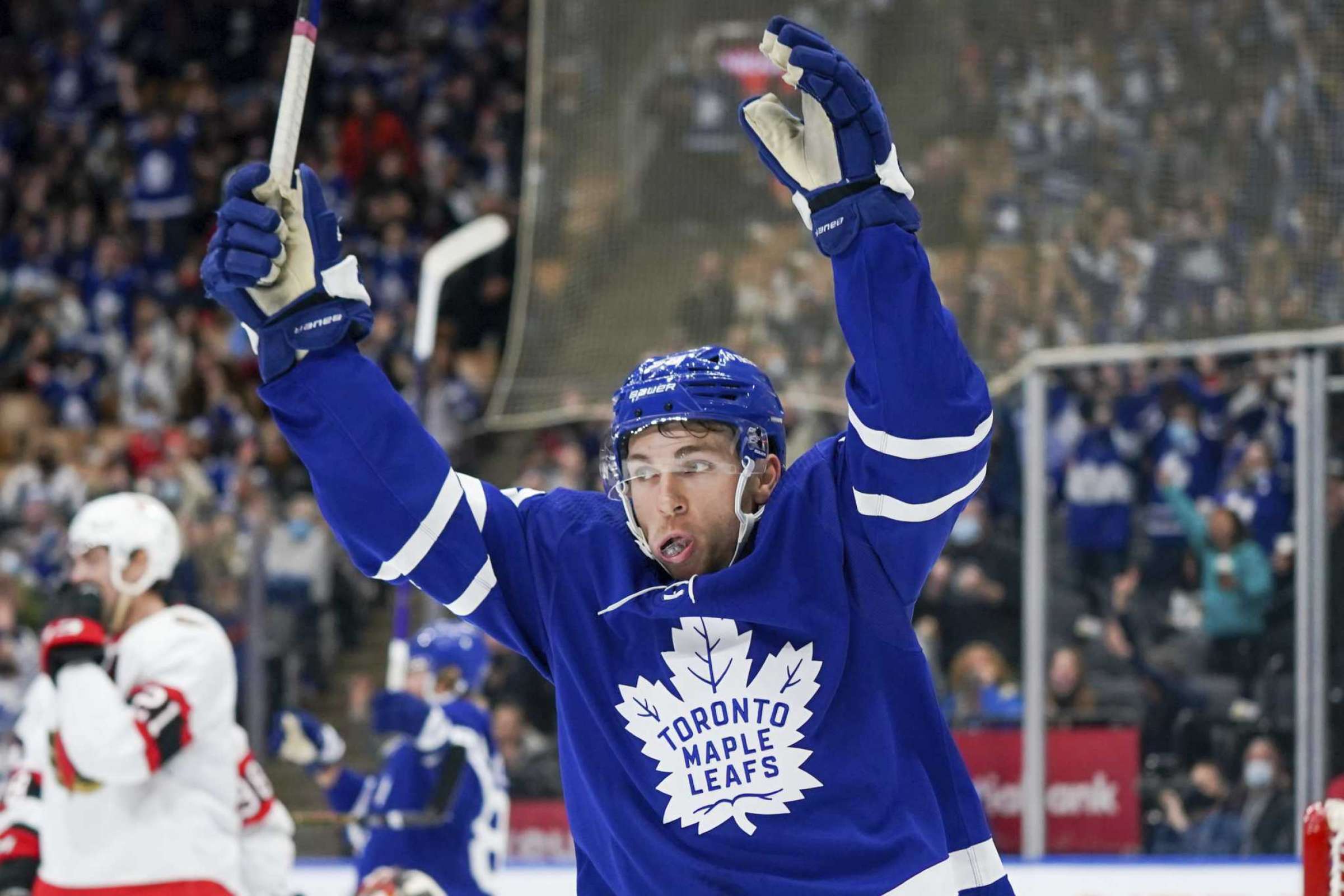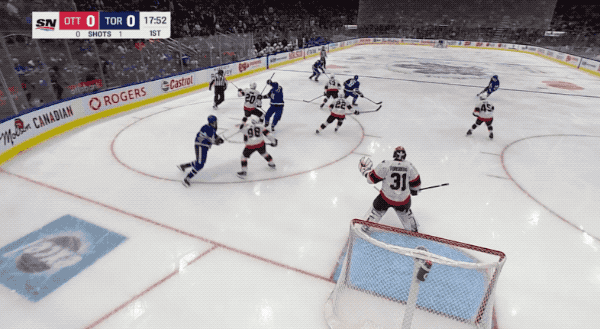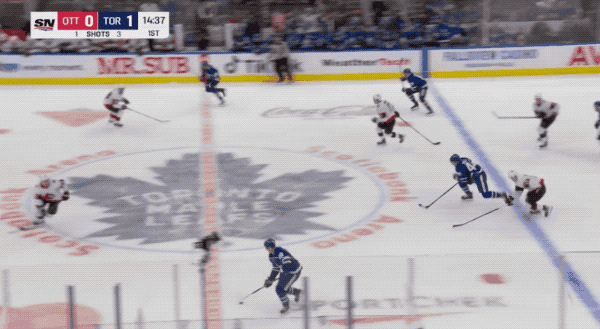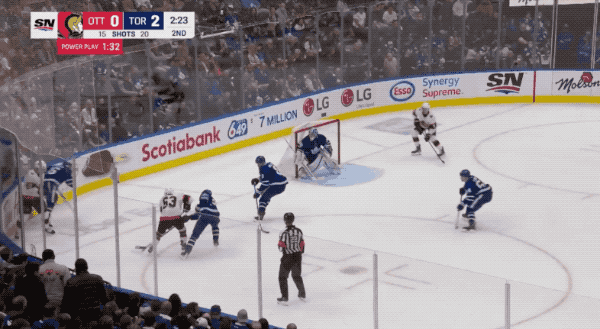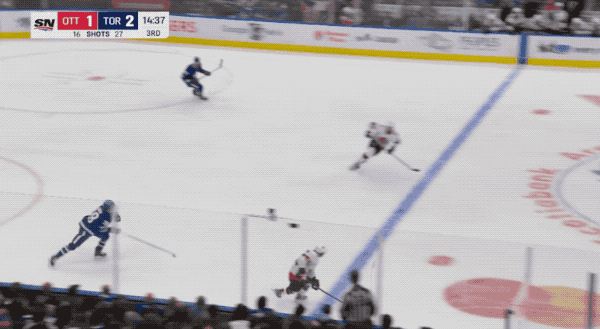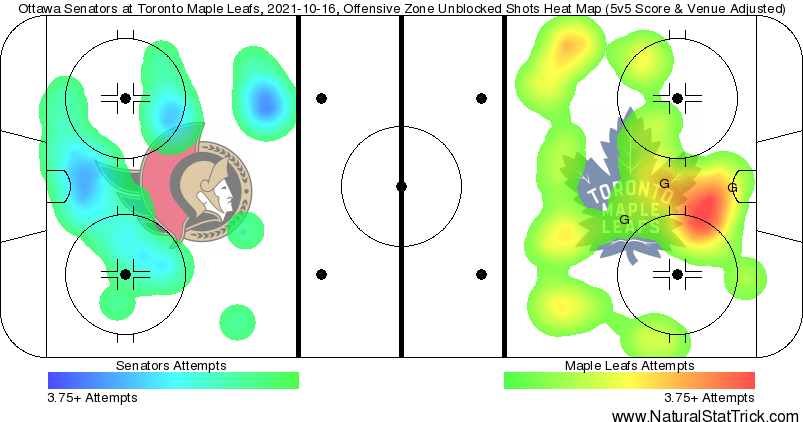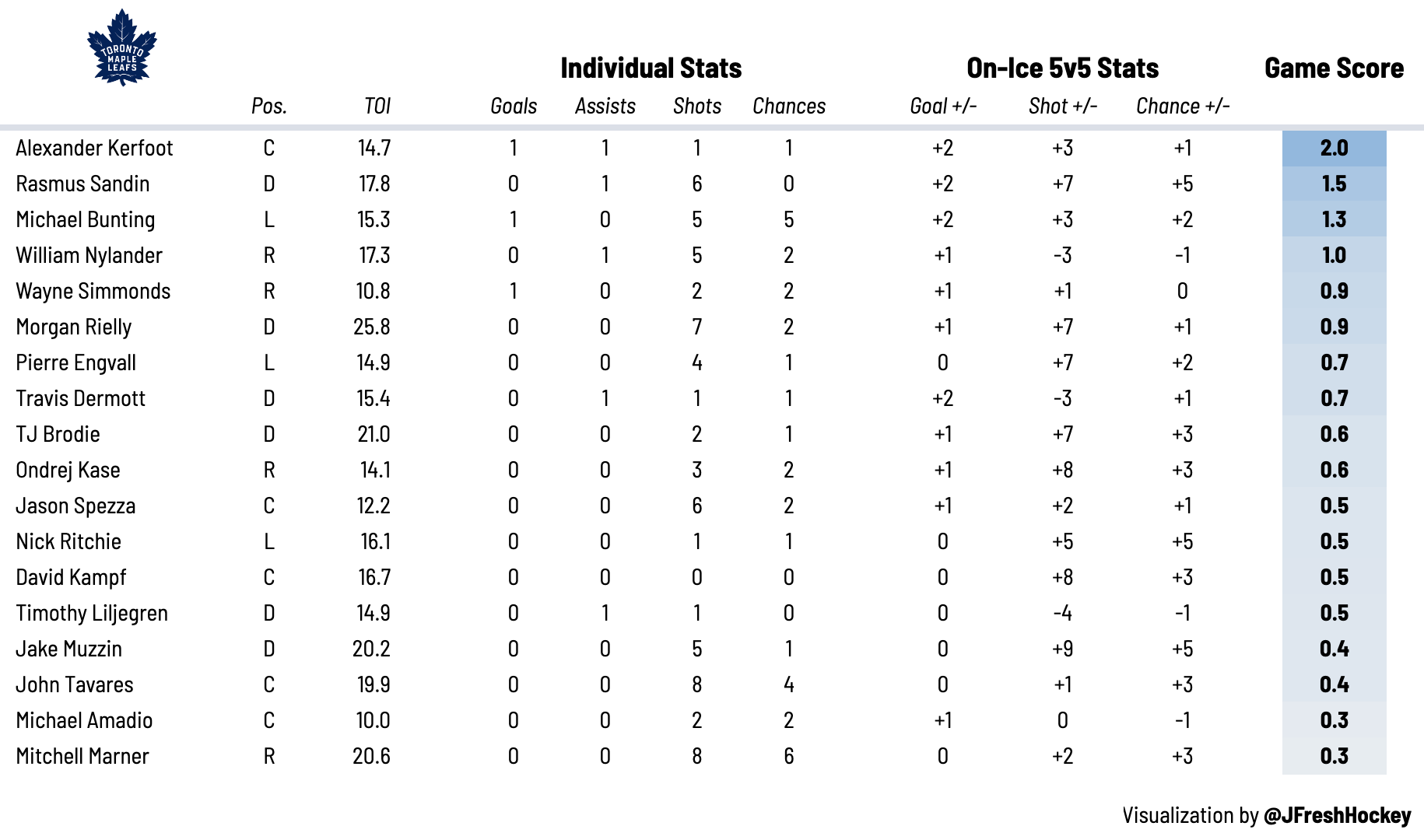Hockey Night In Canada is officially back, baby!
We’ve obviously had some Saturday night Leafs games over the past 16 months, but something just feels different assessing these games played in front of a capacity crowd at Scotiabank Arena.
Maybe it’s energy from the fans. Maybe it’s the fact that normalcy is slowly creeping back into our lives. Whatever it is, I can certainly tell you it’s made these games much more entertaining to analyze than I thought they’d be.
In tonight’s rematch against Ottawa, things went much more according to plan for Toronto. They controlled the run of play at 5v5, got some goal support up front, and as it turns out, didn’t end up needing University of Toronto goaltender, Alex Bishop, in what could have been a David Ayers 2.0 type of game.
What a weird salary cap situation. Anyway, this isn’t an article about the CBA; it’s a postgame analysis column. Let’s get on with the #analysis already and break down some of these players.
It’s time for some Leafs Report Cards!
5 Stars
Rasmus Sandin (LW, #38) — Passing has always been his biggest strength as a player. Given his average size and foot speed, Sandin needs to out-think his opponents if he’s going to make an impact offensively.
He accomplishes that by getting himself open without the puck and threading passes through the middle of the ice when those opportunities present themselves.
Wayne Simmonds picks up the goal here, but that’s all Sandin. It reminds me a lot of Morgan Rielly when he activates down the left wall, draws out an opposing defender, and then makes the game-breaking pass backdoor.
Sandin pulled these passes off a few times tonight, skating downhill from the point and looking directly at the goalie before ripping a pass through the seam.
If that’s Auston Matthews or John Tavares instead of David Kampf, the puck is in the back of the net.
4 Stars
The Second Line — Let’s start with Alex Kerfoot. He’s been the target of criticism on Leafs Twitter lately — and in a fair number of my articles over the last year or so. The biggest reason for this is the contrast between his $3.5m salary and the underwhelming 5v5 results over a large sample, but let’s start with his play tonight.
He was great, finishing the game with a goal on his first shot of the season and a quality feed on a 2v1 rush leading to Michael Bunting’s goal.
The key to making anyone on the Leafs look good is "play them with William Nylander".
— draglikepull (@draglikepull) October 17, 2021
Since 2020, when Kerfoot has played with William Nylander, the Leafs have controlled 57 percent of the shots and 56 percent of the scoring chances at 5v5. Without him: only 49 percent of the shots and 47 percent of the scoring chances (data courtesy of Natural Stat Trick).
This is why I find it so difficult to evaluate Kerfoot. He gets positive results alongside Nylander, much like tonight and during the playoffs. My contention is that this isn’t so much a reflection of Kerfoot’s ability as a top-six forward so much as #88’s ability to turn many players into productive linemates. Just ask Alex Galchenyuk.
Speaking of Nylander, he was excellent again tonight. He was moving his feet without the puck and fighting hard to win pucks back. Even on the penalty kill, he was getting into shooting lanes and clearing the puck for icing. We know he’s an elite puck-carrier when he gets possession, but the fact that he’s putting in so much effort to regain possession is what I’m most impressed with lately.
Now, he only got a shade over 17 minutes tonight with the Leafs leading for most of the night, which is his season-low through three games. The Leafs did a good job of getting him over 18 and 22 minutes in his previous two games. It’s clear this is something they’re trying to address, but I’ll be curious to monitor his ice time once Auston Matthews and Mitch Marner re-unite on the top line.
Last but not least, Michael Bunting was doing Michael Bunting things all evening. Driving hard to the crease and getting hauled down multiple times with no penalty called? Check. Getting lots of chances from in tight and eventually burying one of them after a nice feed from Kerfoot? Check. Having the broadcast mention he’s from Scarborough for the 100th time? Check.
As much as we like poking fun at officiating, Bunting did draw a penalty after getting tripped at the blueline. That was actually halfway through a Leafs power play, giving his team 1:06 with a 5-on-3 advantage. They didn’t end up capitalizing, but the important takeaway is that Bunting drew another penalty, which is something he seems to have a knack for, even if the referees don’t call all of them.
Jake Muzzin (LD, #8) — After really struggling in his first few games, I thought he looked great tonight, especially in the offensive zone. My favourite shift of his came with Sandin right after a Leafs power play had expired. Sandin was free-wheeling around the zone much like Rielly would, while Muzzin manned the point and generated some good looks with his one-timer.
It’s not often one defense partner finishes the game with a +9 shot differential and +5 scoring chance differential (Muzzin), while his partner finishes the game at -4 and -1 respectively (Timothy Liljegren). Those numbers speak to how well Muzzin was driving play, particularly on that extended OZ shift.
Morgan Rielly (LD, #44) — He’s so explosive in transition, jumping up into the play whenever he sees a chance to give Toronto a 3v2 opportunity off the rush. Sometimes, he would skate the puck in himself; other times, he’d make a pass at the line.
There was even one play where he flew in as the trailer and put the puck just a hair over the cross bar. He’s such a dynamic skater when he gets going in transition, and it showed tonight.
Jason Spezza (RW, #19) — Remember when we brought up the importance of linemates in the Sandin section? The quality of your linemates makes a huge impact on your performance.
For example, imagine if this pass lands on the stick of a top-nine calibre NHL forward.
Instead, it landed on Amadio’s stick (and then Simmonds’ stick).
He can’t log major minutes at this stage in his career, but it feels unfair that a playmaker of Spezza’s calibre is forced to play with replacement players every night without a few more opportunities up the lineup. He’s one of Toronto’s best passers, literally leading the team in Assists per 60 last year despite playing with some of the Leafs’ weakest forwards.
Here were Spezza’s most common linemates last year in order of who he spent the most TOI with:
- Joe Thornton
- Travis Boyd
- Alex Kerfoot
- Jimmy Vesey
- Adam Brooks
- Wayne Simmonds
- Nic Petan
For the love of all that is holy, can we please give Spezza a quality NHL linemate on occasion? Is that really so much to ask?
Jack Campbell (G, #36) — There didn’t appear to be too many dangerous scoring chances for Ottawa in this game, so Campbell’s workload wasn’t as difficult as we’d usually expect. That said, he did his job, making all of the saves he was supposed to make.
The only goal he allowed was after an east-west pass on the power play, which is about as high-percentage of a chance you can give up defensively.
This is the one tradeoff of playing an aggressive penalty kill. When your opponent is able to quickly reverse play, you’re left with a lot of bodies stuck on the wrong side of the ice.
3 Stars
Mitch Marner (RW, #16) — Did he finish the night with any points? No. Should he have? Absolutely, which is what I’m going to care more about when I assess these guys on a night-to-night basis. Personally, I’m looking for star forwards to generate high-quality chances offensively.
Marner did that tonight by way of his passing and shooting. He made a few brilliant backdoor passes to teammates, only for Anton Forsberg to come up with a big save. He also had a few chances to score himself, generating a team-high six chances from the slot, one of which came on a breakaway.
“But he’s paid $11 million to produce. Who cares about your nerdy expected goals, I want goals!”
I hear your frustrations. Trust me, I get it. No one likes it when the pucks aren’t going in, but when you’re generating chances at an elite rate, the goals will come. Scoring chances today are goals tomorrow.
Linemate John Tavares generated a few quality looks in this game and remains snakebitten through three games, but I am still seeing him a little behind the play in the neutral zone, on the forecheck, and especially off of the rush in the early going.
Wayne Simmonds (LW, #24) — He scored on that nice feed from Sandin in tight, which is exactly the type of goal you expect Simmonds to score. Unfortunately, the rest of his game didn’t quite go as well, with a bunch of his passes missing the target. In particular, he put one into Liljegren’s skates, causing a turnover and 2v1 chance against.
Travis Dermott (RD, #23) — For the most part, I didn’t really notice Dermott in this game. I’m not sure if that’s a compliment or an insult. We could see it as a positive, since he allowed Sandin to be “The Guy” offensively and hang back a bit more defensively himself.
Or you could say Dermott wasn’t making enough plays with the puck to be noticeable, which is a fair criticism. The good news is that he’s still awesome at timing his 2-on-1 slides.
The ability to prevent that puck from getting across is a valuable one.
Timothy Liljegren (RD, #37) — Leafs fans were really looking forward to seeing a Muzzin-Liljegren pairing considering how strong those two played together in the preseason. The positives were that Liljegren had some good moments defending the rush, keeping a good gap between himself and opposing forwards in transition before closing that gap at the blueline. He also broke up a few cross-ice passes with good stick positioning.
That said, there were some rocky moments for Liljegren when moving the puck, and on a few occasions, attackers players got in behind him, including one instance where he pivoted the wrong way. He’s usually a better breakout passer than we saw tonight, so I’m not too worried in the long run, but he’s still adjusting to the league.
Does he stay on the roster with the Leafs in need of a third goaltender for the next two weeks while Petr Mrazek is on the mend?
The Third Line — To my eye, Ondrej Kase and David Kampf weren’t able to string together many positive plays with the puck up the ice tonight, but a quick look at the box score reveals that Toronto controlled 70 percent of the shots and scoring chances when the third line was on the ice, with a good chunk of their ice time spent against Ottawa’s Tim Stutzle, Josh Norris, and Drake Batherson. That’s tough to complain about.
Pierre Engvall made a few nice plays on the cycle, using his length to shield the puck from opponents and keep his team in possession, but nothing really stood out from his game tonight.
2 Stars
TJ Brodie (RD, #78) — We’ve come to expect more from him. I haven’t loved the plays he’s making with the puck on his stick in the first few games, particularly in the offensive zone. He’s skating himself into bad ice and turning the puck over. He also fired a shot directly into a shin pad, leading to a partial breakaway the other way.
Michael Amadio (C, #18) — He has 175 NHL games to his name, but we haven’t seen many clear signs of his value as an NHL regular as of yet. Amadio works hard along the walls to win the puck back, but he hasn’t been able to make many plays with the puck.
After watching the Toronto Marlies dominate earlier this afternoon, I’d argue there are forwards in this organization who are better than Amadio, but I suppose we’ll keep watching to see if we can spot what Leafs brass likes in the player.
Nick Ritchie (LW, #20) — Sheldon Keefe called it a better game from him on account of his physicality — he also had one half scoring chance crashing the net, and didn’t fully get on the end of the loose puck — but there were some turnovers in the neutral zone, a failure to complete some passes in the offensive zone, and he picked up an unnecessary penalty. We all know he can go hard to the net and finish in tight, but he’s not yet scored or been involved in enough scoring chances to date to justify his spot on the top line (or offset his penalty-taking tendencies).
Heat Map
Here’s a quick look at where each team’s shots were coming from at even strength, courtesy of Natural Stat Trick.
The Leafs controlled 60% of shots and scoring chances at 5v5. The better team doesn’t always win in hockey, but they did tonight.
Game Score
Game score is a metric developed by The Athletic’s Dom Luszczyszyn to measure single-game performance. You can read more about it here.
Keep in mind we don’t have any passing metrics in the publicly available data that these charts use. I’d love to have a seam pass column for guys like Sandin, Spezza, and Marner.
Tweets of the Night
…with control at a super high rate – on over 80% of their breakouts – but entering OTTs zone w/ control well under 40% of the time. It’s all dying for them there in the neutral zone.
— Justin Bourne (@jtbourne) October 17, 2021
This is a great point made by Justin Bourne. The Leafs want to advance the puck up the ice with possession, but they were running into a brick wall when they reach the neutral zone.
The most efficient offense in the NHL is created immediately after gaining the zone with possession, which is something the Leafs will need to improve if they’re going to slice through tight-checking teams in the playoffs. That and the infamous “greasy goals” Sheldon Keefe wanted them to score more off of rebounds in the “All Or Nothing” documentary.
They should’ve put him in lucky number 90
— David Ayres (@Davidayres901) October 16, 2021
Sometimes Twitter can be a good place!
…and sometimes it can be a toxic cesspool.
I feel like a lot of Leaf fans should have taken a break from the team this season.
— Todd Leigh Offside (@Totally_Offside) October 16, 2021
SaMe OlD LeAfs, WhErE wAs MaRnEr ToNiGhT!!!1!???
This is going to be a long regular season, isn’t it?
Scarborough’s very own 🇨🇦 #LeafsForever pic.twitter.com/GudknhhL3t
— Toronto Maple Leafs (@MapleLeafs) October 17, 2021
Wait, Michael Bunting’s from Scarborough?















![John Gruden after the Leafs prospects’ 4-1 win over Montreal: “[Vyacheslav Peksa] looked really comfortable in the net… We wouldn’t have won without him” John Gruden, head coach of the Toronto Marlies](https://mapleleafshotstove.com/wp-content/uploads/2025/09/gruden-post-game-sep-14-218x150.jpg)








